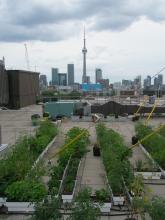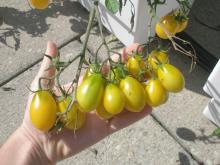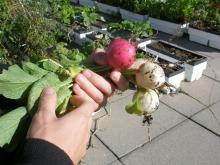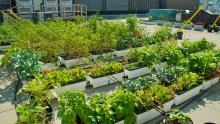Lightweight Rooftop Vegetable Gardens
The Food and Water Institute (FWI)
Objective
The objective of Rooftop Gardens Inc. is to design and build year-round rooftop vegetable gardens that are lightweight so they don’t exceed the structural capacity of standard flat rooftops. These gardens will serve private citizens, restaurants, community groups and schools by providing local, organic produce on site for kitchens and nutrition programs.
Background
Toronto offers an abundance of flat, open rooftop spaces that are perfect for vegetable gardens. Green roofs are rapidly gaining popularity in Canada, but their potential could be greatly increased if we consider the question: what if we use rooftops for agriculture? In Toronto we have a vast potential to grow tonnes of food on our rooftops, yet large rooftop gardens are rare. This is due to the short growing season, as well as the cost and structural constraints of incorporating a rooftop garden suitable for growing vegetables. Rooftop Gardens Inc. offers solutions to these obstacles, as outlined below:
Rooftop Gardens Inc. solutions to urban agriculture obstacles for Canadian cities:
Space
Obstacle: Limited space, soil may be unsuitable, theft from community or public gardens
Solutions: Acres of flat, open, sunny rooftop spaces; fresh organic soil and compost; privacy
Water
Obstacle: High irrigation needs, access to water, fertilized water runs off into sewer system
Solutions: Collect rainwater; drip irrigation system conserves water; fertilized water is recycled within the system
Growing Season
Obstacle: short May-October season; harsh winters
Solutions: four-season harvest; sustain cool-weather crops in passive-solar, lightweight greenhouse
Technology
Obstacle: Intensive; heavy soil requirements; most rooftops cannot structurally support a vegetable garden
Solutions: Lightweight semi-hydroponic or aeroponic containers; organic fertilizers to maximize yield; compost garden waste for use as fertilizer
Knowledge
Obstacle: Lack of awareness with respect to horticulture and where our food comes from
Solutions: Showcase health and environmental benefits of local, organic food; educate community about urban agriculture through our partner organization, The Food and Water Institute (FWI)
Innovation
Rooftop Gardens Inc. designs are unique because they are lightweight and enable year-round food production:
- Designs incorporate the use of lightweight semi-hydroponic or aeroponic containers;
- In Ontario, the average load capacity for a flat roof is 195 kg/m2 and an intensive green roof generally imparts loads of around 450 kg/m2 and up. A semi-hydroponic garden built by Rooftop Gardens Inc., complete with water, soil, mature vegetation, and a greenhouse will weigh no more than 100 kg/m2;
- Containers are watered via drip irrigation which results in little wasted water, no soil erosion and uniform distribution;
- Organic fertilizers and compost teas are easily added to the irrigation system and distributed to plants;
- Irrigation and fertilization can be automated with a timer to minimize maintenance;
- Gardens can be made more self-sufficient through on-site composting, seed saving, and rainwater capture
- We provide access to organic vegetable seeds and plants that have been grown for generations on a rooftop, and are thus adapted to the environment
- Four-season gardening is achieved using innovative lightweight, inflatable greenhouses that enable the continuous harvest of cool weather crops such as salad greens throughout the winter months.
Pilot Garden
The SkyGarden, located at the University of Toronto, is our pilot installation, developed in collaboration with the Food and Water Institute and the University. In two growing seasons SkyGarden has produced over 350 kg (800 lbs) of organic vegetables in a surface area of only 50 m2. The SkyGarden is self-sustaining: plants are grown from seed collected from the previous year’s harvest and garden waste is composted and used as a soil amendment. Other features of the garden include a honeybee hive and a solar dehydrator, built through workshops facilitated by FWI. Upcoming additions to the garden include a lightweight greenhouse and experimental cold frames, to continue the harvest year-round.
Cost
Individual containers retail for $50. Overall cost depends on the number of containers and whether or not an irrigation system is required. Our system design is approximately $120 per m2 for large installations (>100 containers, or 50 - 100 m2). This cost estimate is based on the design of our pilot garden, and includes an automated drip irrigation system. Our pilot garden yields indicate that based on the value of organic produce grown alone, the payback time of the capital cost for our system is 2-3 years.
Contrast this to a traditional green roof which costs approximately $150 - $375 per m2 for an intensive system, i.e., one with soil deep enough to grow some vegetables. This cost does not include an irrigation system, prices of which vary widely as they are generally customized for the specific design. However, it is not uncommon for the irrigation system to nearly double the cost of the installation.
Benefits
Rooftop Gardens Inc. offers an affordable and effective solution overcoming obstacles in constructing urban rooftop gardens. In doing so, the community can dramatically reduce its ecological and carbon footprints and experience the many health and environmental benefits of growing and eating local, organic and seasonal food.
Direct Reductions - Heating and Cooling Energy Savings
Direct emission reductions within the city are related to savings on heating and cooling costs. Studies have shown that vegetation on a building exterior (rooftop, walls) can provide a measure of insulation and reduce the energy needed to control the temperature of the interior of the building. Rooftops are particularly important because, for many urban buildings, they have the hottest temperatures in the summer and they are the site of the most heat loss in the winter.
Heating:
A study by researchers at U of T and Environment Canada demonstrated that green roofs reduce energy consumption in winter by preventing heat loss. For a typical mixed-use (residential and commercial) 3-story space in downtown Toronto, the green roof resulted in a reduction in heating energy of 34% or 6015 kWh for the winter season. That translates to 1125 kg of CO2 for just one building, based on the TAF conversions. For a residential home, the same study estimated heat energy savings of ~5% or 385 kWh, which translates to 72 kg of CO2 emissions per home.
Cooling:
A City of Toronto study noted the benefits of vegetated rooftops in decreasing air conditioning requirements for the buildings. They calculated energy savings on air conditioning at 4.15 kWh/m2 of vegetated rooftop. This translates to 0.77 kg of CO2 per sq. meter of vegetated rooftop.
Reduction of Urban Heat Island:
In large cities, non-vegetated surfaces like rooftops and concrete absorb solar radiation, the surface temperature rises, and with it the surrounding air temperature. This is the urban heat island effect. So, if we increase urban vegetation coverage we can lower the air temperatures and that heat island effect. Adding this vegetation to rooftops turns a liability into an asset. At a large scale, in theory we could reduce the air temperature enough to lower air conditioning requirements in summer.
A 2004 City of Toronto study on the benefits of green roofs concluded the following:
- widespread implementation of vegetated rooftops would reduce air temperatures in Toronto by 0.5 to 2 degrees Celsius
- This translated to energy (cooling) savings of 2.37 kWh/m2 of vegetated rooftop
- The CO2 emission reduction from power generation translated to 32,300 metric tonnes per year
Indirect Reductions - Food Miles
Developing low cost, low energy, four-season rooftop gardens will provide year-round, local and organic produce in the urban environment. In doing so, the potential decreased “food miles” is significant and will act to reduce greenhouse gas and smog causing emissions associated with food transportation.
Local, organic food has a much lower associated carbon footprint than conventionally grown food which has travelled great distances from farm to dinner plate, and that uses excessive chemical fertilizers and pesticides. In Toronto, local food items travel an average of 101 km versus imported food items which travel an average of 5,364 km. A local study on food miles done by Waterloo Public Health concluded that 10 commonly consumed foods in the region had traveled an average of 4,497 km and accounted for 51,709 tonnes of greenhouse gas emissions annually. The study also pointed out that these were foods that were able to be produced within the region. The same study showed that selecting locally-sourced foods, rather than imported foods, would result in an annual reduction of 49,485 tonnes of greenhouse gas emissions in that region alone, the equivalent of taking 16,191 cars off the roads. The potential emission reductions in Toronto with increased rooftop agriculture are significant. In addition, extending the harvest to the entire year using passive energy, lightweight greenhouses increases the availability of local food during winter months when food is imported in even greater quantities and/or produced in energy-intensive, heated greenhouses.
Indirect Reductions - Organic Agriculture
Organic agriculture is more effective at capturing atmospheric CO2 and sequestering it in the soil as beneficial organic matter; in contrast, conventional farming results in a net release of CO2 to the atmosphere. These results are based on a long-term (23 year) study by the Rodale Institute. The same study also estimates that converting one medium-sized farm to organic production stores an amount of carbon in the soil equivalent to taking 117 cars off the road. For 10,000 farms that is equivalent to taking 1,174,400 cars off the road.
In addition, eliminating the use of pesticides, herbicides, and fertilizers made from fossil fuels will further reduce the impact of these rooftop gardens.
Heather Wray is in the final year of her PhD in civil and environmental engineering at the University of Toronto. She also has a MSc in ecology. Prior to beginning her PhD, Heather worked for a green building design firm in Montreal, where she designed and implemented greywater recycling and four-season gardening for local projects.
The Food and Water Institute (FWI) is a Canadian registered charity and believes that it is the right of all Canadians to have access to healthy food and water that is free from unwanted chemicals. The Food and Water Institute shares science-based information about food and water safety, and challenges consumers to make informed choices. FWI maintains SkyGarden at U of T, where educational workshops and seminars are held. Examples of workshop topics include composting, seed saving, building a solar dehydrator and urban beekeeping.
Casey Wong is an industrial designer and a founding partner at Citra design, a Toronto design consultancy specializing in high quality technical solutions for architecture, interactions and living. Citra design is working with Rooftop Gardens Inc. and FWI to develop and install an inflatable greenhouse concept at the University of Toronto SkyGarden.
Erika Richmond is finishing a masters in Landscape Architecture at the University of Toronto. Before beginning her masters degree, Erika operated a small green roof design and construction company in Vancouver. She has also worked at and volunteered at many urban agriculture projects in Toronto and Vancouver.
Rooftop Gardens Inc. will be self-supporting in under five years by charging consulting, installation and equipment fees to the individuals and organizations that purchase our products and services.
Revenues from the installation of three paid projects the size of SkyGarden (100 containers) would enable Rooftop Gardens Inc. to cover minimal operational expenses for a period of 12 months.
Funds from Climate Spark will allow Rooftop Gardens Inc. to 1) design and manufacture new innovative rooftop garden technologies, 2) establish an organizational presence by securing desk space and bringing on a paid intern, 3) establish a strong brand and develop and implement our marketing and communications strategic plan, and 4) support educational workshops and seminars to teach urban gardeners new skills in collaboration with the Food and Water Institute.
Comments
Waht a fantastic idea!
You have done a great job. The time has come. As your project spread around roof tops, logistics of managing supply and demand would be a main concern. You may need to create a co-operative entity so that each roof top gardeners would concentration on their time spending for own plot productivity.
In Haiti, I saw a business man who specializes roof top gardening. He supplies fresh vegetables to supermarkets. 95% of buildings in Haiti have flat roofs. He became a very rich man. I tell you what I saw through one of my friends there in Haiti. The man developed a special garden technology; long plastic pipes, 4 to 6 inches in diameter, with open holes on top of the pipe at an interval are arranged traced down facing noon sun. Inside the pipes a root holding material is filled and water laden with plant nutrients is pumped through the pipes. All kinds of beautiful healthy vegetables are grown in the holes. This technology is sophisticated yet very productive, it seems.
Wonderful idea
It,s a wonderful idea, but the chalenges facing the implementation of this project seem for my opinion to be to many.
It goes from the logistic perspective to the extension of it.
By initiating it as a pilot project, so it would help do an evaluation on what it needs to get it extended.
Clearly expressing your business value – Mock Press Release
Each proposal in ClimateSpark is bringing a valuable community based idea forward to help with energy conservation and the reduction of carbon emissions
Centennial College, School of Communications Media & Design, Corporate Communications and Public Relations Class of 2012 will be working on a set of mock press releases, in anticipation of this proposal being one of the 20 to be selected on October 31 to continue to ClimateSpark Ignite Phase 2.
If you would like to be interviewed as part of the mock press release development process, please send a note to Professor Barry Waite, [email protected] by Friday October 21, 2011.
If you choose not to be interviewed, the mock press release will be developed based on Information currently posted in the description of your idea, as well as information gleaned from the various comment interactions.
a question or two
I can't claim to be an expert on this issue, so just have 2 questions.
I love the idea of rooftop gardening that doesn't require strengthening the structure, but what makes your approach lighter than existing roof gardening technology? Once you add water, is it really any lighter? And what are the costs of a typical application? I'd love to see this as an affordable option.
Emission reduction potential
Everyone loves gardens and local food, and giving city-dwellers an opportunity to get their hands in the dirt a bit is lovely. But from an emission reduction perspective, how does this add up? Imported food does have a big carbon footprint, which is technically called "scope 3" because not emitted directly here. You say the emission reduction in Toronto is "significant".
Could you elaborate on the emission reduction potential of this venture.
Love this!
This is a great idea -- where do I sign up for a consultation?
Would like to see more practical information about setting something up, i.e., costs, feasiblity study etc.
I think this is a great idea
I think this is a great idea - strong concept that needs to grow in Canadian cities.. literally! :)
Great!!
I love this idea, I think a bit of rooftop greenery is what Toronto needs to balance out the glass and steel jungle thats shooting up everywhere.
You can eat fresh organic produce. Every day!
Fabulous project!
What a great opportunity for those of us who are urban dwellers to reduce our environmental footprint and to learn more about the joys and challenges of food production. I hope this project 'grows' around the city!
Wonderful idea
The population of earth has reached 7 billion. We NEED projects like this in order to somehow feed a population that is only going to get larger. This project is making use of the limited space urban areas do have and will contribute to the overall health of our Toronto citizens. I see this project as a wonderful launching pad for other health, community and educational projects as well.
The biggest weakness would be implementing the education and execution of actually tending to and growing the food gardens. However with a strategy in place, this can be overcome.
I agree with above comments, that there should be a more comprehensive breakdown of cost to individuals, businesses and organizations.
Good proposal!
With the population of the world increasing, especially in urban areas which are getting more and more populated, this proposal outlines a simple way to create both a cost effective plan, and a good use of both space and natural resources. The natural heating a cooling of the air on these rooftops create a very effective use of the natural climate to create these products, as opposed to having to use energy to create the desired climates.
Finally, the health benefits of eating local and non-imported fruits and vegetables proves to be quite valuable for city dwellers who may not otherwise get this opportunity.
I agree with many of the other suggestion in the idea that there should perhaps be some type of outline in the proposal that states the cost, to the city, residents, buildings, and other significantly impacted resources. With this in mind, this propsal would be very educational and complete.
The store is easier
I like to idea but there is too much competition with super markets
Keep on plugin
Good concept! Rooftop garden
Good concept! Rooftop garden space is a huge opportunity - potentially an opportunity to collaborate with the GardenShare submission.
The ClimateSpark Social Venture Challenge is a project of:

Our sponsors:

















I think this is a great idea.
I think this is a great idea. Too bad all roofs are not flat nor support the weight of a garden. The proposal seems well thought out. For densely populated areas it is ideal.
Just a side note that there may be some safety issues of people being up on a roof.